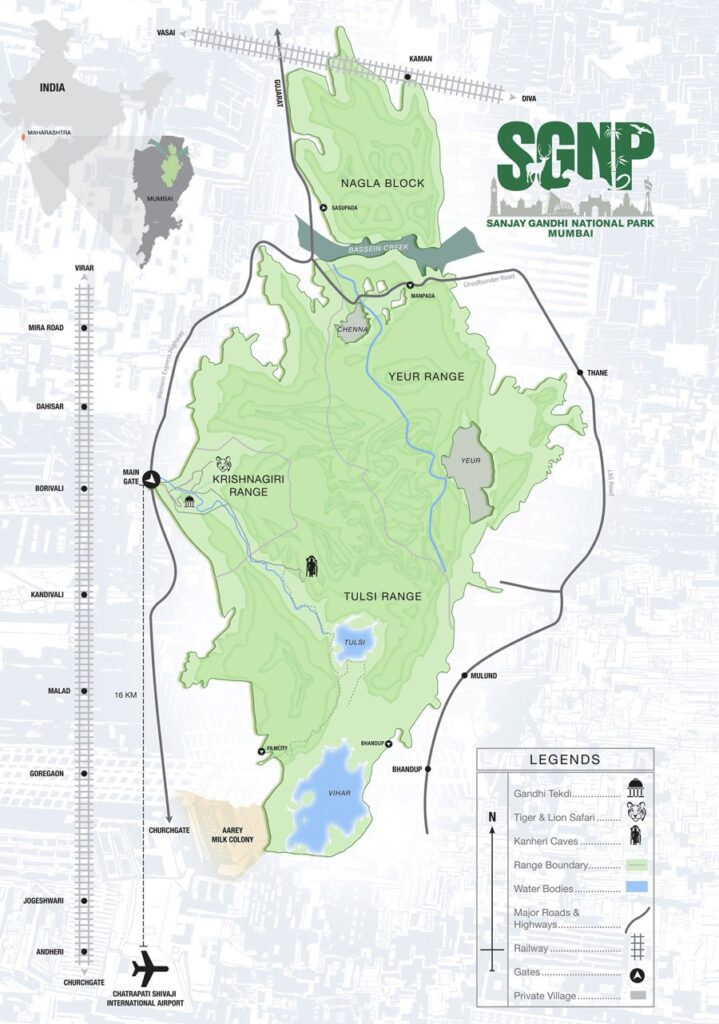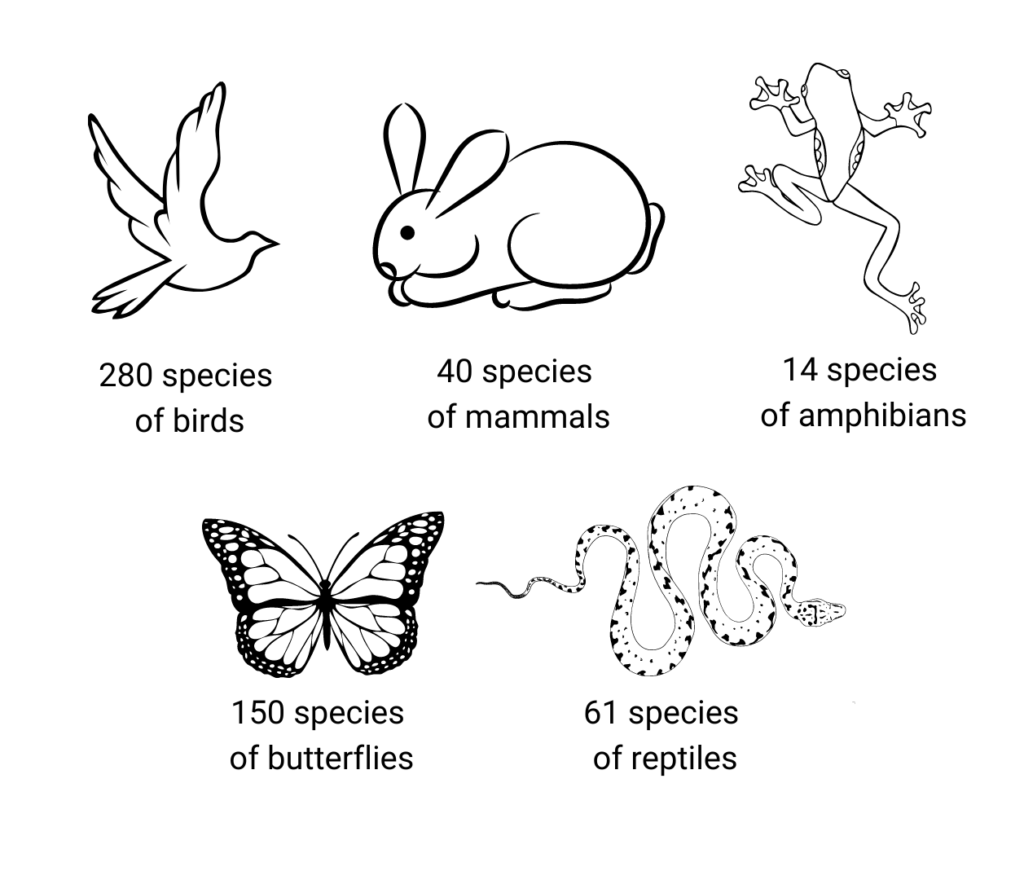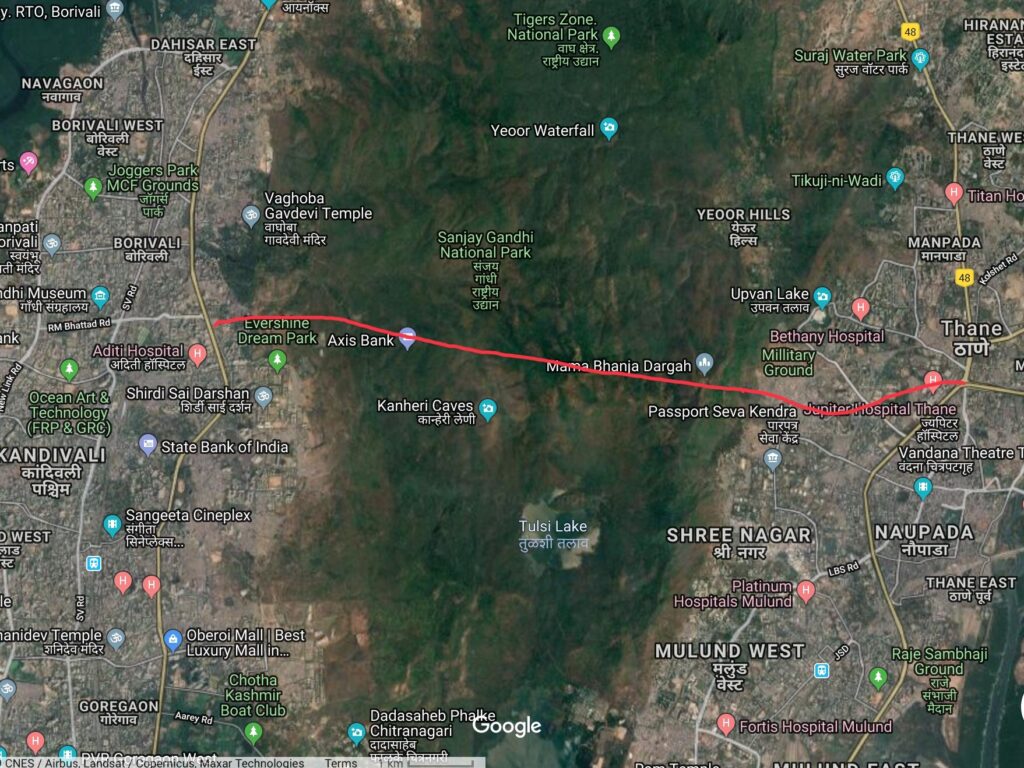This article is based on a detailed case study compiled by the author for the Centre for Financial Accountability.
Common imagination of a national park takes us all to rural countryside landscapes, but the Sanjay Gandhi National Park presents a different picture. Located inside the city of dreams, the financial and urban capital of India, Bombay, sits nestled in the Sanjay Gandhi National Park. Spread over 103 sq km, SGNP forms 20 per cent of Mumbai’s geographical area and is known worldwide for being the only protected area within the limits of a metropolitan region.
It houses within itself a public recreational area of 5.75 sq. km, a buffer zone of 10.38 sq km and a core zone of 86.96 sq. km, along with two of Mumbai’s largest lakes- Vihar and Tulsi lakes. This ecological landscape was notified as a “protected area” due to the construction of these lakes in the nineteenth century. The history of SGNP is interwoven with the legal history of Aarey Forest, the thick dense landscape of forests adjacent to SGNP that also faces the threat from the politics of development.

SGNP is the only national park in the Malabar Coast of the Western Ghats, one of the least represented biogeographic zones. In recent years, SGNP has gained the spotlight for being the only urban protected area housing 47 leopards at present. The park is also known for flamboyant flowering blooms of Karvi or Strobilanthes callosus. The north side of SGNP is connected to Tungareshwar WLS and along with Aarey form an extended green corridor for the leopards to move around. The changes brought about by human intervention over the years have shaped and influenced the biodiversity of SGNP making it both a unique and fragile ecosystem. SGNP and Aarey forests are also home to the Warli community who have lived here for generations and who worship Waghoba/Waghdevi, the tiger god, which they believe is the elder brother of the leopard. About three thousand people living in twelve padas (villages) reside within the SGNP boundaries.

Acknowledged by the Warli people as their home, by the State and by city residents as the lungs of Mumbai and declared by law as a protected area, the ecology of SGNP is suffocating from the developmental air that the State is pumping into it. CFA, in their report Rise In Infrastructure Projects In Protected Areas: A Self-Defeating Goal For Development, highlights that SGNP has the highest number of projects for a protected area landscape. A total of 43 projects, which includes some of the most aspirational and expensive infrastructure projects that India is inaugurating for the first time, intruded upon SGNP.
A Look Into the Developmental Within SGNP
Banked by technical and economic support from Japan through Japan International Cooperation Agency (JICA), India is coming with its two mega railway projects, both passing through SGNP. The Western Dedicated Freight Corridor (WDFC), a 1500 km long stretching railway project, is planned to run from Dadri near Delhi to JNPT in Mumbai. With funding of Rs 8,553 crores, it is being executed by the Dedicated Freight Corridor Corporation of India (DFCCIL). Aspiring to raise and invite foreign export and direct investment, the project aims at linking industrial parks and harbours of the states between Delhi and Mumbai. It passes through SGNP and its ESZ, diverting 71.0119 ha of forest land in total with 8.050 ha of forest land inside SGNP.
Adding to that is the High-Speed Railway Project for which the Experts Committee in 2015 prioritized the Mumbai-Ahmedabad route. Being executed by the National High-Speed Rail Corporation Ltd, the project will mark the introduction of the Shinkansen High-Speed Railway System in India and is budgeted at Rs. 1.08 lakh crore.
Interestingly, both projects have been exempted from Environmental Clearance (EC) and Environment Impact Assessment (EIA) study by the MoEFCC. The WDFC project was given Wildlife Clearance (WC) in 2015 with conditions of fencing, building underpasses and Rs. 15 crores deposition to SGNP authorities for conservation.
Understanding the global push for these projects, JICA has inked agreements totalling ₹ 15,295 crores with the central government for three mega-rail infrastructure projects. Other than the WDFCC, JICA has granted ₹4,262 crores for the Mumbai Trans Harbor Link Project and ₹2,480 crores for the Mumbai Metro Line-3 Project. The most controversial is the Metro Car shed-3 project by the Mumbai Metro Rail Corporation Limited in Aarey, which the current state govt is pushing with all its might, in spite of the wide-scale resistance from the people.
What Are the Other Projects in SGNP?
The Virar- Alibaug MultiModal Corridor project which consists of a road, bus transit system, and metro line passes will take 14.8 hectares of SGNP land and is budgeted at ₹ 2,250 crores. It will also pass through the buffer zone of Tungareshwar Sanctuary, Karnala Bird Sanctuary and Matheran Eco-Sensitive Zone. The submitted proposal documents show a lot of information and bureaucratic discrepancies and were flagged in 2018 and remain incomplete to date. In July 2019, the screening committee formed under the Department of Economic Affairs (DEA) recommended that for securing the movement of wildlife between the forests, “multiple crossing points for wildlife be constructed”. But on July 4, in a meeting of the board of directors, the project’s authority was suddenly transferred from Mumbai Metropolitan Region Development Authority (MMRDA) to Maharashtra State Road Development Corporation Limited (MSRDC). Interestingly, while the state govt has already exempted the project from environmental clearance (EC), the Maharashtra Coastal Zone Management Authority (MCZMA) has mandated the need for Forest Clearance (FC) and recommended the matter to High Court (HC).
Sadly, adding to projects on the surface, SGNP is seeing the very first-of-its-kind work wherein tunnels have been proposed to pass underneath a protected area. The Borivali- Thane Twin Tunnel Project costs ₹300000 lakhs and will connect the Western Express Highway (WEH) near Borivali and Ghodbunder road near Tikujiniwadi and have a 10 km stretch running underneath SGNP.

The Goregaon- Mulund Tunnel Link Road costing ₹200000 lacs is the other project starting from Goregaon Film City and ending at Mulund near Amar Nagar with a 4.7 km tunnel that will occupy about 21.5 hectares of subterranean area under the national park. Both projects now are being executed by MMRDA.
In both cases, the executing agencies had submitted applications seeking environmental clearance in 2017. The MoEFCC declined the EC requirement and never granted the Terms of Reference by saying that the proposed project is not a national highway or state highway and thus non-admissible under EIA Notification, 2006. It is interesting to note that in the case of GMLR, the ToR was initially granted in 2018, but the MoEFCC in its 187th meeting delisted the project and exempted it from both EC and EIA citing the above reason. Aaditya Thackery gave a green flag to GMLR through its inauguration on 14th April 2022.
Additionally, SGNP will also see the construction of a 4.5 km elevated flyover road, a four-lane elevated road being built over the existing four lanes in name of decongesting traffic. It is critical to note that Mangrove forests are present on either side of the existing road which will be felled for this project. Costing ₹ 667 crores and executed by the MSRDC, the project has already received approval from the state government in 2018 and is awaiting to acquire wildlife clearance from the Standing Committee-National Board of WildLife (SC-NBWL) and Supreme Court (SC).
A study done by the Wildlife Institute of India, Wildlife Conservation Trust and then Additional Principal Chief Conservator of Forests (APCCF) Mangrove Cell reported major leopard deaths from this road which is the link between the southern block of Sanjay Gandhi National Park with its Nagla Block on the Northern side further connecting it with the Tungareshwar wildlife sanctuary (TWLS). In this light, the committee’s suggestions on regulating traffic through speed restrictions and constructing underpasses show the irony and demand critical questions on the effectiveness of mitigation when the reasons that endanger wildlife are allowed to continue.
In response to concerns about animal safety due to the multiple developmental projects, the state greenlighted the creation of an Animal Passage corridor to be constructed between Sanjay Gandhi National Park and Tungareshwar Wildlife Sanctuary. Reported to resemble the Singapore Animal Overpass, the corridor will have both an overpass and an underpass built by the Dedicated Freight Corridor Corporation of India ( DFCCIL). The approval for the corridor was granted on 3rd February 2021 by the order of the Principal Chief Conservator of Forests (PCCF) detailing,
The design of the corridor will resonate with the natural vegetation of the surrounding areas and elements like rocks, logs and water bodies will be added to make the animals feel at home.
Seeing the design of the passage, however, gives the first impression of an aspirational and expensive infrastructure project in the name of mitigation that objectifies wildlife as a disciplined, monitored and obedient machine.
Contesting the “Development at all Cost” Claim
In June 2022, the Supreme Court issued an order mandating all protected forests to have an eco-sensitive zone (ESZ) of a minimum of one km from the demarcated boundary. The Maharashtra government in this regard has strongly opposed this and moved the High Court citing it will “hamper development” in the SGNP. Over the years, the state has cleared the land falling under ESZ for major development activities, including major projects elaborated above and even opening up the areas to builders, real estate and private players. The opposition to these developmental sprees has been minimal, in fact, the developers association especially from Maharashtra have approached the court for relief from the ESZ order, citing how private builders have crores of investment underway in SGNP. Ironically, the elite conservationists and even the government have been forcing evictions of the marginalized communities that have settled on marginal land sizes around SGNP framing them as potential degraders of SGNP.
Sunita Keni who is 27 years old and lives inside SGNP elaborated upon this in conversation.
My grandparents were born on this land, we have always lived here with wagh (leopard). But Park authorities want us to move out, they deny us electricity meters, restrict us from grazing cattle and monitor if any support comes to us but nobody puts restrictions on these projects. Who will the projects benefit? Who are they for? Neither the pada people nor the forest and definitely not the leopards.
“Any development project carried out within or around the SGNP is definitely bound to result in harm to the landscape and its ecology. Linear intrusions crossing through the park will lead to fragmentation of habitat and hamper wildlife movement. In planning and pushing development projects we have to take into account the ecology, we have to think of the leopards and the wildlife”, elaborates Nikit Surve from the Wildlife Conservation Society.
It’s not just the forest ecosystem of SGNP but also the connectivity of SGNP with other adjacent ecosystems such as Aarey Forest, Tungareshwar Wildlife Sanctuary, that is being broken. Anwar Ahmed, SGNP Director and Chief Conservator in an interview with the HT times commented, “Despite just a 90-meter gap between SGNP and TWLS, leopards are unable to cross. We are developing a mitigation plan for the corridor. Each leopard should have at least 6 sq km area as its natural habitat. With several infrastructure projects such as the bullet train, multi-modal corridor and Panvel-Virar railway line, intersecting with sections of SGNP, the habitat is likely to get squeezed further”.
Ten leopard deaths directly related to road accidents have been reported since 2016. Data from SGNP, Wildlife Protection Society of India (WPSI) and Mumbaikars for SGNP revealed that nineteen leopards have been killed around SGNP, most of them on the Western Express Highway (WEH) from 2008 to 2018. Not just leopards, but monkeys, wild boars, civet cats, mongoose, snakes and deer have also faced accidents as reported by forest officers.
Leopards living in SGNP have been branded globally but the concerns remain – how much pressure can they take in this urbanizing fragmenting shrinking green space? How long can development define and drive conservation?
False Promises and Fragmented Concerns: Who Cares for the Ecology?
“All this government push for big projects into SGNP and Aarey is causing shrinking of existing forest and coastal ecosystems, destruction of catchment areas of lakes, loss of habitat for wildlife. This is an alarming situation when Mumbai is already seeing a rise in flooding issues, increased temperatures and alarming heat waves” says Amrita Bhattacharjee, an environmental activist from Mumbai who has also challenged the project Green Wheels along Blue Lines in the High Court.
Mumbai is part of C40 Cities Climate Leadership Group and the Thackeray govt in mid march this year launched a Mumbai Climate Action Plan, aiming at reducing emissions to meet the climate goals outlined in the Paris Agreement to limit global warming to 1.5 °C. Drafted by the Municipal Corporation of Greater Mumbai (MCGM) with support from World Resources Institute (WRI) India, this plan declares key actions including urban greening and biodiversity along with working on energy, sustainable mobility, and air quality. In light of the big infrastructure, developmental and transport projects coming, and the constant shrinking of green spaces, these action plans seem to be all lies and deceit. This also becomes crucial because the Intergovernmental Panel on Climate Change (IPCC) recently released the second part of the Sixth Assessment Report (AR6), highlighting the impact of climate change on megacities.
The Report predicts a rise in cyclones, floods, surface temperatures, and heatwaves in the case of Mumbai. As reported by Deutsche Welle (DW), “According to a 2017 report, the per capita tree density of Mumbai was just 0.28, compared to an ideal tree-human ratio of seven trees for every person.” These alarming figures suggest the critical role that SGNP and Aarey play as green ecosystems in a concretizing landscape. But the state’s decisions to revive war rooms to facilitate quick advancement in development projects suggest otherwise.
When asked if Sunita dreams of living outside in the city, she immediately responded, “No- we see and worship wagh on an everyday basis, not like tourists who come for a single day. We do not want to go into any buildings or city, we feel happy in our land. We exist because of the forests, forest is our community, it is our home” The forest, wildlife, and tribal people struggle to claim their home in the city of dreams that dreams only of development and infrastructure.
Featured image of a leopard in a Warli settlement near SGNP, courtesy of Nayan Khanolkar via Twitter.






